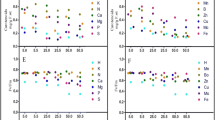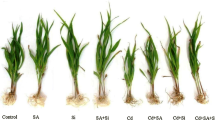Abstract
Cadmium contamination is a critical constraint to plant production in agricultural soils in some regions. Cerium is one of the rare earth elements, it plays a positive role in plant growth with a appropriate content. The present study was conducted to examine the role of cerium nutrition in the amelioration of effects on cadmium toxicity in rice (Oryza sativa L.) seedlings by a hydroponic experiment. Measurements included growth condition, photosynthesis related parameters, chloroplast ultra-structure and antioxidant enzymes content. Our results showed that the growth of rice seedlings was markedly inhibited by cadmium (100 μM), and the inhibition was significantly alleviated by cerium (10 μM). Fresh weight, single seedling height and chlorophyll content of rice plants in cerium treated groups were increased by 24.4, 18.2 and 32.05 % compared to those of plants cultivated in only cadmium-present condition. Additionally, in cadmium treated plants, the addition of cerium significantly increased the value of the maximum quantum yield of primary photochemistry (F v /F m ), indicator of PSII ‘structure and functioning’ (SFI ABS ) and the performance index on absorption basis (PI ABS ), elevated the activity of whole chain electron transport activity, enhanced photophosphorylation and its coupling factor Ca2+-ATPase activities. The result showed that the chloroplasts and thylakoid membrane of the rice seedlings leaves grown in cerium treatment developed better than that in cerium-absent group under cadmium toxicity. Moreover, addition with 10 μM cerium mitigated cadmium stress by inducing leaf enzyme activities for antioxidation like superoxide dismutase, peroxidase and catalase, dramatically depressed superoxide (O ·−2 ), hydrogen peroxide and malondialdehyde accumulation. Results indicated that alleviation of cadmium toxicity by cerium application is partly related to improved light-use-efficiency, increased antioxidant enzymes, decreased oxidative stress in rice seedlings.




Similar content being viewed by others
References
Appenroth KJ, Stöckel J, Srivastava A, Strasser RJ (2001) Multiple effects of chromate on the photosynthetic apparatus of Spirodela polyrhiza as probed by OJIP chlorophyll a fluorescence measurements. Environ Pollut 115:49–64
Boscolo PRS, Menossi M, Jorge RA (2003) Aluminum-induced oxidative stress in maize. Phytochemistry 62:181–189
Cao FB, Wang NB, Zhang M, Dai HX, Dawood M, Zhang GP, Wu FB (2013) Comparative study of alleviating effects of GSH, Se and Zn under combined contamination of cadmium and chromium in rice (Oryza sativa). Biometals 26:297–308
Clemens S (2006) Toxic metal accumulation, responses to exposure and mechanisms of tolerance in plants. Biochemi 88:1707–1719
Duman F, Aksoy A, Aydin Z, Temizgul R (2011) Effects of exogenous glycinebetaine and trehalose on cadmium accumulation and biological responses of an aquatic plant (Lemna gibba L.). Water Air Soil Pollut 217:545–556
Farooq MA, Ali S, Hameed A, Ishaque W, Mahmood K, Iqbal Z (2013) Alleviation of cadmium toxicity by silicon is related to elevated photosynthesis, antioxidant enzymes; suppressed cadmium uptake and oxidative stress in cotton. Ecotox Environ Safe 96:242–249
Heath RL, Packer L (1968) Photoperoxidation in isolated chloroplasts I: kinetics and stoichiometry of fatty acid peroxidation. Arch Biochem Biophys 125:189–198
Hong FS (2002) Study on the mechanism of cerium nitrate effects on germination of aged rice seed. Biol Trace Elem Res 87:191–200
Hossain MA, Hasanuzzaman M, Fujita M (2010) Up-regulation of antioxidant and glyoxalase systems by exogenous glycinebetaine and proline in mung bean confer tolerance to cadmium stress. Physiol Mol Biol Plant 26:259–272
Hu YL, Ge Y, Zhang CH, Ju T, Cheng WD (2009) Cadmium toxicity and translocation in rice seedlings are reduced by hydrogen peroxide pretreatment. Plant Growth Regul 59:51–61
Juang KW, Ho PC, Yu CH (2012) Short-term effects of compost amendment on the fractionation of cadmium in soil and cadmium accumulation in rice plants. Environ Sci Pollut Res 19:1696–1708
Kukier U, Chaney RL (2002) Growth rice grain with controlled cadmium concentrations. J Plant Nutr 25:1793–1820
Liang CJ, Huang XH, Zhou QL (2006) Effect of cerium on photosynthetic characteristics of soybean seedling exposed to supplementary ultraviolet-B radiation. J Environ Sci China 18:1147–1151
Lin L, Zhou WH, Dai HX, Cao FB, Zhang GP, Wu FB (2012) Selenium reduces cadmium uptake and mitigates cadmium toxicity in rice. J Hazard Mater 235–236:343–351
Liu DW, Wang X, Lin YS, Chen ZW, Xu HZ, Wang LN (2012) The effects of cerium on the growth and some antioxidant metabolisms in rice seedlings. Environ Sci Pollut Res 19:3282–3291
Mao CX, Chen MM, Wang L, Zou H, Liang CJ, Wang LH, Zhou Q (2012) Protective effect of cerium ion against ultraviolet B radiation-induced water stress in soybean seedlings. Biol Trace Elem Res 146:381–387
Maxwell K, Johnson GN (2000) Chlorophyll fluorescence-a practical guide. J Exp Bot 51:659–668
Najeeb U, Jilani G, Ali S, Sarwar M, Xu L, Zhou WJ (2011) Insights into cadmium induced physiological and ultra-structural disorders in Juncus effusus L. and its remediation through exogenous citric acid. J Hazard Mater 186:565–574
Nwugo CC, Huerta AJ (2008) Effects of silicon nutrition on cadmium uptake, growth and photosynthesis of rice plants exposed to low-level cadmium. Plant Soil 311:73–86
Pandey P, Srivastava RK, Dubey RS (2013) Salicylic acid alleviates aluminum toxicity in rice seedlings better than magnesium and calcium by reducing aluminum uptake, suppressing oxidative damage and increasing antioxidative defense. Ecotoxicology 22:656–670
Piotrowska A, Bajguz A, Godlewska-Żyłkiewicz B, Zambrzycka E (2010) Changes in growth, biochemical components, and antioxidant activity in aquatic plant Wolffia arrhiza (Lemnaceae) exposed to cadmium and lead. Arch Environ Contam Toxicol 58:594–604
Roháček K (2002) Chlorophyll fluorescence parameters: the definitions, photosynthetic meaning, and mutual relationships. Photosynthetica 40:13–29
Sanità di Toppi L, Gabbrielli R (1999) Response to cadmium in higher plants. Environ Exp Bot 41:105–130
Shah K, Kumar RG, Verma S, Dubey RS (2001) Effect of cadmium on lipid peroxidation, superoxide anion generation and activities of antioxidant enzymes in growing rice seedlings. Plant Sci 161:1135–1144
Sharma P, Dubey RS (2007) Involvement of oxidative stress and role of antioxidative defense system in growing rice seedlings exposed to toxic concentrations of aluminum. Plant Cell Rep 26:2027–2038
Shi GR, Cai QS, Liu CF, Wu L (2010) Silicon alleviates cadmium toxicity in peanut plants in relation to cadmium distribution and stimulation of antioxidative enzymes. Plant Growth Regul 61:45–52
Souza JF, Dolder H, Cortelazzo AL (2005) Effect of excess cadmium and zinc ions on roots and shoots of maize seedlings. J Plant Nutr 28:1923–1931
Stewart RRC, Bewley JD (1980) Lipid peroxidation associated with accelerated aging of soybean axes. Plant Physiol 65:245–248
Strasser RJ, Srivastava A, Tsimilli-Michael M (2000) The fluorescence transient as a tool to characterize and screen photosynthetic samples. In: Yunus M, Pathre U, Mohanty P (eds) Probing photosynthesis: mechanism, regulation and adaptation. Taylor & Francis Press Publishing, London, pp 445–483
Van Heerden PDR, Strasser RJ, Krüger GHJ (2004) Reduction of dark chilling stress in N2-fixing soybean by nitrate as indicated by chlorophyll a fluorescence kinetics. Plant Physiol 121:239–249
Vassilev A, Manolov P (1999) Chlorophyll fluorescence of barley (Hordeum vulgare L.) seedlings growing in excess of Cd. Bulg J Plant Physiol 23:67–76
Wellburn AR (1994) The spectral determination of chlorophylls a and b, as well as total carotenoids, using various solvents with spectrophotometers of different resolution. J Plant Physiol 144:307–313
Xiong J, Lu H, Lu KX, Dugan YX, An LY, Zhu C (2009) Cadmium decreases crown root number by decreasing endogenous nitric oxide, which is indispensable for crown root primordia initiation in rice seedlings. Planta 230:599–610
Yu GH, Li W, Yuan ZY, Cui HY, Lv CG, Gao ZP, Han B, Gong YZ, Chen GX (2013) The effects of enhanced UV-B radiation on photosynthetic and biochemical activities in super-high-yield hybrid rice Liangyoupeijiu at the reproductive stage. Photosynthetica 51:33–44
Ze YG, Zhou M, Luo LY, Ji Z, Liu C, Yin ST, Duan YM, Li N, Hong FS (2009) Effects of cerium on key enzymes of carbon assimilation of spinach under magnesium deficiency. Biol Trace Elem Res 131:154–164
Zhang MP, Zhang CJ, Yu GH, Jiang YZ, Strasser RJ, Yuan ZY, Yang XS, Chen GX (2010) Changes in chloroplast ultrastructure, fatty acid components of thylakoid membrane and chlorophyll a fluorescence transient in flag leaves of super-high-yield hybrid rice and its parents during the reproductive stage. J Plant Physiol 167:277–285
Zhang CH, Li QQ, Zhang MX, Zhang N, Li MH (2013) Effects of rare earth elements on growth and metabolism of medicinal plants. Acta Pharm Sin B 3:20–24
Zhou M, Ze YG, Li N, Duan YM, Chen T, Liu C, Hong FS (2009) Cerium relieves the inhibition of photosynthesis and growth of spinach caused by lead. J Rare Earth 27:864–869
Zhou M, Gong XL, Wang Y, Liu C, Hong MM, Wang L, Hong FS (2011) Cerium relieves the inhibition of chlorophyll biosynthesis of maize caused by magnesium deficiency. Biol Trace Elem Res 143:468–477
Acknowledgments
This research was supported by the National Natural Science Foundation of China (No. 31271621), the Priority Academic Program Development of Jiangsu Higher Education Institutions (PAPD) and NSFC for Talents Training in Basic Science (J1103507, J1210025).
Author information
Authors and Affiliations
Corresponding author
Rights and permissions
About this article
Cite this article
Wu, M., Wang, PY., Sun, LG. et al. Alleviation of cadmium toxicity by cerium in rice seedlings is related to improved photosynthesis, elevated antioxidant enzymes and decreased oxidative stress. Plant Growth Regul 74, 251–260 (2014). https://doi.org/10.1007/s10725-014-9916-x
Received:
Accepted:
Published:
Issue Date:
DOI: https://doi.org/10.1007/s10725-014-9916-x




